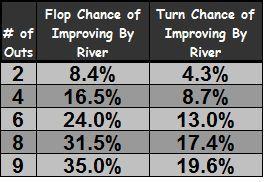What Is a Draw in Poker? | Texas Hold’Em Drawing Hand Basics

In poker, there are two sorts of post-flop hands with value: made hands and drawn hands. Made hands are easier to play than draws because they are more straightforward. In reality, understanding what a drawN hand is and how to play it is an often overlooked but crucial part of playing Texas Hold’em, or any poker game for that matter.
So, what is a poker draw? A drawing hand in poker is when a player holds an unmade hand that is unlikely to be the best on the current street but has the potential to “draw” to the best hand if a specific card is dealt on the turn or river. The flush or straight draw are the most popular drawings that come to mind for most people.
Drawing hands come in a variety of strengths, ranging from a gutshot straight draw (4 potential outs) to a powerful combo draw, such as a straight draw with a flush draw (up to 15 outs).
Must Read: Vegas Hotel With 2 Tub
What Exactly Is an Out?
A potential future card that could be dealt on the turn or river and improve a poker hand is known as an out. Outs are usually associated with cards that might boost a player’s chances of winning. If you had Ace King and the board was 952, for example, all Aces and Kings remaining in the deck would be called “outs,” as either of them would make you top pair.
What Is a Flush Draw and How Does It Work?
When your hole cards and community cards both have 5 of the same suit, you have a flush. A flush draw occurs when one or both of your hole cards have the potential to complete a flush on the following street.

There are some flush draws that are better than others. When you have two of the same suit in your hand and two on the board, or when you have the Ace of one suit in your hand and three of the same suit on the board, you have the strongest flush draw. Due to the reverse implied odds, having a single card flush draw that is not to the nuts (the best hand conceivable) is generally a sucker hand to play.
What is Reverse Implied Odds, and how does it work?
If you have reverse implied odds, you might strengthen your hand yet still lose to a superior draw. The weaker your flush draw is, the more likely reverse implied odds will be a problem. As a result, unless two cards in your hand are suited, you should avoid betting a lot of money on a flush draw. Straight draws, on average, have fewer problems with reverse implied odds.
What is the definition of a straight draw?
When one or both of your hole cards allow you to form a five-card straight on the next street, you have a straight draw. The open-ended straight draw is the most typical straight draw that most people are familiar with. When one or both of your cards are in the middle of the community cards, you have eight possible outs to make a straight.

While reverse implied odds issues are less likely in straight draws, they are nevertheless feasible. The “dummy” end of the straight is when your cards are at the bottom of a potential straight and there are hands that can build a greater straight. When all eight cards are to the nuts, the finest straight draw is known as an open-ended straight draw.
Must Read: Garden Buffet Review
Is There Anyone Else Drawing?
Yes. In fact, any hand that has a clear path to becoming the best hand on either the Turn or the River is considered a drawing hand. Here are several examples:
- Bottom pair, with five outs for trips, or two pair
- A gutshot straight draw with four possible outs from a straight.
- A backdoor flush draw, which can result in a flush if the correct suit appears on the turn and river.
Examples of the above hands are given in the image below, in the same sequence as written.
The options are limitless. What matters most is evaluating which draws are worth continuing with and then selecting the appropriate lines to optimize the predicted value. It takes a lot of time and effort to master tactical play in these spots.
What Are the Chances of Making a Draw by the River or Turn?
One of the most essential fundamentals in texas hold’em is understanding the probability of drawing hands. The number of outs you have determines your chances of completing a draw. Based on the amount of outs, here is a poker outs probability chart that shows the odds of making a couple of the most common draws on the turn or river.
An Easy Math Shortcut to Assist You in Determining the Odds
You can estimate your chances of hitting a flopped draw on the turn or on the river if you remember the numbers 4 and 2. Multiply your projected number of outs by 4 to calculate your chances of improving by the river. Multiply your predicted number of outs by two to increase your chances of improving on the turn. That’s all there is to it.

Of course, the figures will not be exact and will be wrong by about 1% the majority of the time. Even so, it’s close enough at the table to make informed selections. Just to be sure, let’s put it to the test. Let’s say you have an open-ended straight draw and want to know how frequently you’ll hit your straight by the river. Because an open ender has eight outs, we increase it by four to get 32. If you look at the graph above, you’ll see that the actual amount is 31.5 percent, which is quite close. Feel free to experiment with a few different options to get the hang of it.
What Makes Drawing Hands So Important?
Let’s get a little more sophisticated now and look at the reasoning behind why sketching hands are so valuable. In short, they do well versus powerful made hands and have considerably superior equity against nuts (the strongest hand available) or near nuts, especially on the turn.

Equity is the percentage of the pot that your hand would win if everyone in the pot were to go all-in right now on this street. When you compare the equity of a made hand like top pair to the nuts, you’ll notice that the latter has a very slim chance of winning on the river. On the other hand, your average low flush draw will normally beat the stone cold nuts by the river more than 1 in 3 times.
When compared to QJo on an AKT, 32s with a two-card flush draw has a 33% chance of winning the pot on the river, and 36% if your opponent does not share a suit with you. See the results below, which were calculated using Pokerstove, a tool that calculates raw flop equity using known hole cards and the board.
Take a look at how top pair performs in comparison to the identical hand.
Only 7.5 percent of your money is invested! You can see the full effect of drawings now. It is far preferable to hold a draw than a medium-strength hand, such as top pair, against an opponent who is likely to have a very wide range.
While it’s preferable to have a draw over a made hand when facing a very powerful hand, the actual power of a draw comes from the fact that your opponent(s) may fold and you can grab the pot without a fight. Fold equity refers to the additional money you win when you obtain a fold.
Fold Equity’s Influence
The fact that a draw is profitable has nothing to do with the fact that you are actually making your hand. Even the most powerful draws will have less than 50% equity on the flop. It would be nearly impossible to show a profit with a draw if no one ever folded. Take a look at this graph from a recent game in which I was holding either a flush draw or a straight draw.
As you can see, I made a lot of money with my draws, but I would have lost if it weren’t for the non-showdown gains I earned through fold equity. When I gambled and my opponents folded, I made these “red line” earnings. “Semi-Bluffing” is the term for this.
What exactly is a semi-bluff?
Semi-bluffing is when you represent a made hand by betting or raising when on a draw. One of the reasons skilled poker players win is not because they have the best hand at showdown more than everyone else, but because they can force opponents to fold their best hand. Draws are the best hands to “bluff” with since they are most likely to improve on the next street. As a result, bluffs with a lot of equity, such as flush draws or straight draws via semi-bluffs, are the most effective.
Summary
Mastering how to play a variety of hands after the flop is one of the keys to understanding how to play winning poker. You must not only understand how to optimize the worth of your created hands, but also how to maximize the value of your sketching hands. In fact, understanding how the equity of created hands vs. draws works might mean the difference between losing and winning. As a result, learning how to play a drawing hand is critical.



